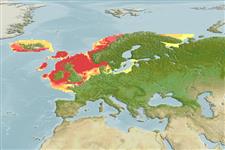Malacostraca |
Decapoda |
Crangonidae
Environment: milieu / climate zone / depth range / distribution range
Ecology
Benthic; depth range 20 - 360 m (Ref. 106124). Temperate; 70°N - 46°N, 28°W - 46°E
Northeast Atlantic: from White Sea (Russia) to northern Bay of Biscay (France), including Iceland.
Length at first maturity / Size / Weight / Age
Maturity: Lm ?, range 1 - ? cm
Inhabits depths from 20 to 360 m (Ref. 106124). Epibenthic (Ref. 87524). Occurs over coarse sand along continental coasts (Ref. 96391). Also found in substrates of sludge (Ref. 96352) and mud (Ref. 2817).
Mating behavior: Precopulatory courtship ritual is common (through olfactory and tactile cues); usually indirect sperm transfer (Ref. 833). Life cycle: Females moult upon release of brood (Ref. 106470).
Harms, J. 1993. (Ref. 2711)
IUCN Red List Status (Ref. 130435)
CITES status (Ref. 108899)
Not Evaluated
Not Evaluated
Threat to humans
Human uses
| FishSource |
Tools
Internet sources
Estimates based on models
Preferred temperature
(Ref.
115969): 6.9 - 10.8, mean 8.2 (based on 331 cells).
Resilience
High, minimum population doubling time less than 15 months (K=1.4-1.49).
